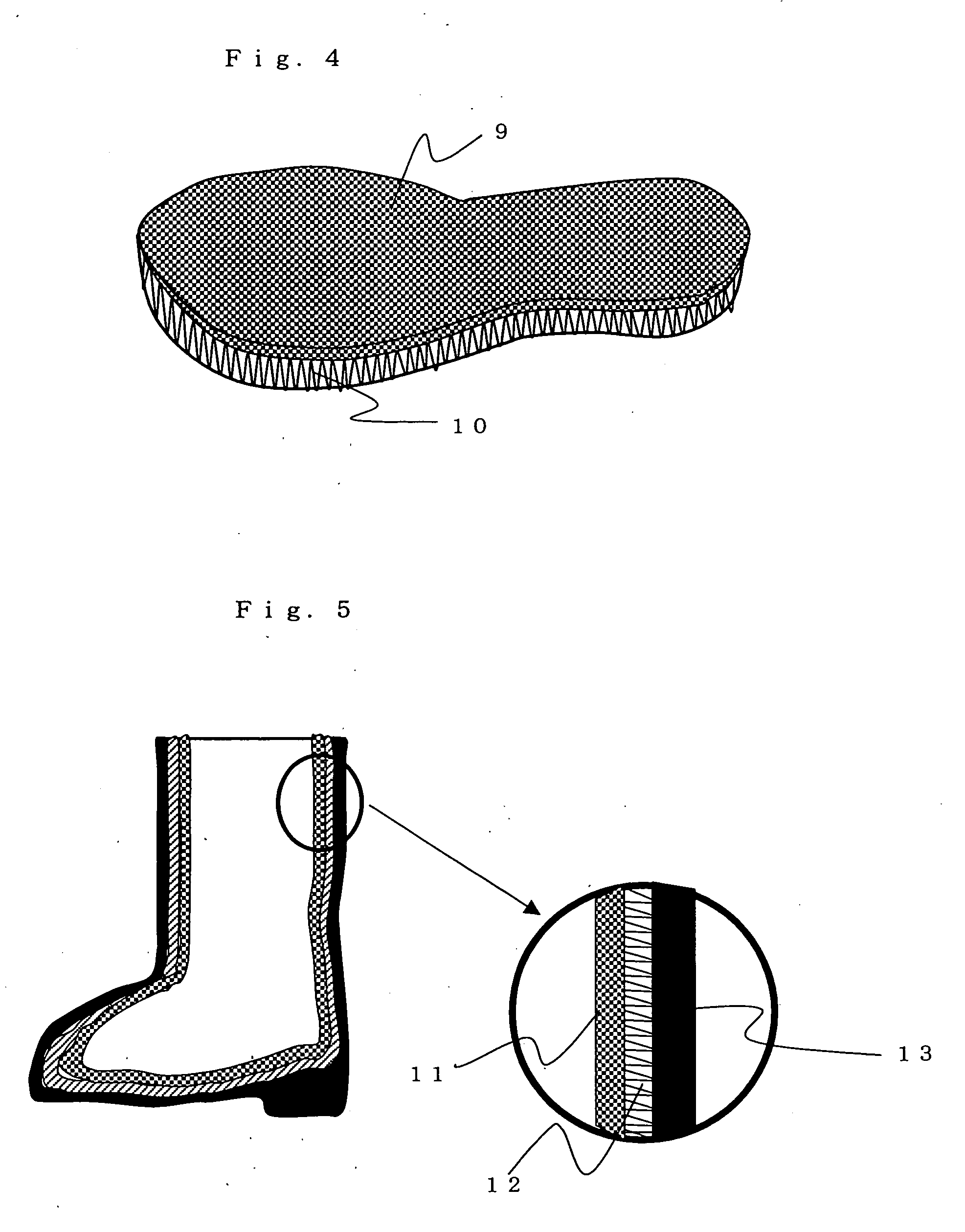Internal Material of Sole, Shoe Insole and Boot
a technology of shoe insole and inner material, which is applied in the field of inner material of shoe, can solve the problems of heavy weight, poor air permeability, and produced stuffy feeling, and achieve excellent lightweight properties, air permeability, and cushioning properties
- Summary
- Abstract
- Description
- Claims
- Application Information
AI Technical Summary
Benefits of technology
Problems solved by technology
Method used
Image
Examples
example 1
[0062] 38% (by weight) of polybutylene based terephthalate obtained by polymerizing an acid component resulting from mixing terephthalic acid and isophthalic acid in a ratio of 80 / 20 (% by mole) and butylene glycol was further reacted under heating with 62% (by weight) of polybutylene terephthalate
[0063] (molecular weight: 2,000), thereby obtaining a thermoplastic block copolymerization polyether ester elastomer. This thermoplastic elastomer had an intrinsic viscosity of 1.0, a melting point of 155° C., an elongation at break of film of 1,500%, a 300% stretch stress of 2.94 Pa (0.3 kg / mm2), and a 300% stretch recovery of 75%. By using this thermoplastic elastomer as a sheath part and usual polybutylene terephthalate (melting point: 230° C.) as a core part, an elastic composite fiber yarn was spun in a usually method such that a weight ratio of the core part to the sheath part was 60 / 40. This elastic composite fiber yarn is an eccentric core / sheath type composite fiber. This elastic...
example 2
[0070] An internal material of shoe was heat molded in the same manner as in Example 1, except that in Example 1, prior to sticking the surface skin onto the mat layer, the surface of the mat layer in the sticking side was sliced by 3 mm in a thickness so as to have a thickness of 9 mm. As a result, sticking of the surface skin was easy. Furthermore, in the resulting internal material of shoe, the surface of the surface skin was flat.
example 3
[0071] A mat layer (T / W=4.1, basis weight: 525 g / m2, thickness: 15 mm, density: 0.035 g / cm3) was obtained in the same manner as in Example 1, except that in Example 1, 30% (by weight) of the same elastic composite fiber as in Example 1, 50% (by weight) of the same hollow polyethylene terephthalate short fiber as in Example 1, and 20% (by weight) of a hygroscopic and exothermic fiber (SUNBURNER, trade name, manufactured by Toho Textile Co., Ltd.) were blended. Subsequently, a central part thereof was sliced to form two sheets.
[0072] On the other hand, 20 / 1 of a hygroscopic and exothermic fiber (SUNBURNER, trade name, manufactured by Toho Textile Co., Ltd.) and a usual polyethylene terephthalate multifilament yarn (84 dtex / 48 fil) were interknitted at a weight ratio of the former to the latter of 30 to 70, thereby forming a knit fabric (basis weight: 230 g / m2).
[0073] Subsequently, such a knit fabric was stuck onto the sliced surface of the mat layer in the same manner as in Example ...
PUM
| Property | Measurement | Unit |
|---|---|---|
| Temperature | aaaaa | aaaaa |
| Percent by mass | aaaaa | aaaaa |
| Thickness | aaaaa | aaaaa |
Abstract
Description
Claims
Application Information
 Login to View More
Login to View More - R&D
- Intellectual Property
- Life Sciences
- Materials
- Tech Scout
- Unparalleled Data Quality
- Higher Quality Content
- 60% Fewer Hallucinations
Browse by: Latest US Patents, China's latest patents, Technical Efficacy Thesaurus, Application Domain, Technology Topic, Popular Technical Reports.
© 2025 PatSnap. All rights reserved.Legal|Privacy policy|Modern Slavery Act Transparency Statement|Sitemap|About US| Contact US: help@patsnap.com



